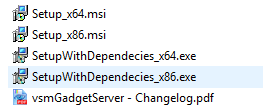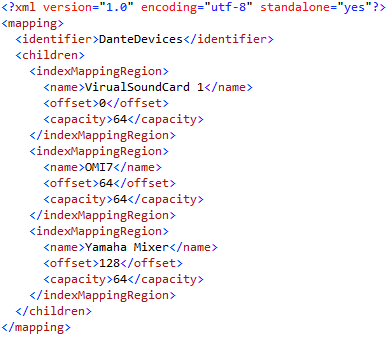Interface - Dante Network to control audio routes
Introduction
With the release of Version 16.1 in January 2016, VSM is supporting the control of Audio over IP streaming in a Dante network.
General Information
Dante is a complete media networking solution. Dante distributes uncompressed, multi-channel digital media via standard Ethernet networks. If a piece of audio equipment is Dante-enabled, this means that it is capable of transmitting and/or receiving audio channels to/from other Danteenabled equipment over a standard local area network running Internet Protocols (TCP/IP, UDP/IP etc).
When a Dante-enabled device is connected to an IP/Ethernet network, it will automatically:
- Configure its IP address
- Advertise itself to allow automatic discovery
Supporting automatic discovery, a Dante-enabled device will advertise information about itself to other Dante devices and Dante Controller, including:
- Device name
- Audio channel labels
- Number of audio channels
- Sample rates and bit depths
A Dante device has a number of channels associated with it. These are either transmit (Tx) or receive (Rx) channels. Transmit channels are advertised on the network. A receiver uses this advertisement to establish a subscription to the channel. A transmit channel can be sent to multiple receivers using unicast or multicast.
Receive channels are connected to transmit channels via a subscription. Each receive channel will receive audio over the network from at most one transmit channel.
For more Dante specific technical details, network specifications, or functional explanations, please refer to http://www.audinate.com/
Dante Routing Terminology
- Device: A device means a Dante-enabled device, and more specifically that component of the audio equipment that implements the Dante interface. A Dante device typically has Tx and Rx channels and other routing-related properties.
- Transmit (Tx) channel: A transmit channel transmits audio from the audio hardware onto the network.
- Receive (Rx) channel: A receive channel receives audio from the network and sends it to the audio hardware.
- Flow: Dante audio routing creates flows. Each flow carries several channels of audio from a transmitter to one or more receivers. Unicast routing creates flows to single receivers. Multicast routing creates flows that can be received by multiple receivers. Multicast flows are assigned IDs enabling them to be identified in Dante Controller.
- Unicast routing: Unicast flows are point-to-point from a single transmitter to a single receiver. Unicast flows typically have room for 4 channels of audio.
- Multicast routing: Multicast flows are one-to-many from a single transmitter to any number of receivers. Use Dante Controller to choose which channels are to be multicast. Unlike unicast routing, multicast flows consume network bandwidth even if there are no receivers, but do not require additional bandwidth to add more receivers.
- Subscription: A subscription configures a receive channel to receive audio from a transmit channel on another Dante device.
- Subscription status: For a receive channel, subscription status indicates whether it is subscribed, whether it is receiving unicast
VSM Integration
The objective of controlling Dante through VSM was to enable VSM operators to discover and route device channels through a Dante Audio over IP network. The integration has been done in vsmGadgetServer 5.4. VSM Studio does not talk directly to a Dante network.
To discover devices and channels, vsmGadgetServer 5.4 does not talk directly to Dante-enabled devices. Instead, it interfaces with a Dante controller service. This service runs on the same PC/Server as vsmGadgetServer 5.4, and acts as a proxy of the attached Dante network.

As shown in this scheme, vsmGadgetServer 5.4 relies completely on the information presented through the control service. This means vsmGadgetServer 5.4 must not be changed when new Dante-enabled devices are introduced. Dante-enabled devices known to the Dante control service are automatically available to VSM.
vsmGadgetServer 5.4 and the Dante control service reside on the same machine. The control service is a substantial component of the Gadget Server Install and it will be copied to the machine, when the “setup with dependencies” is installed.

The *x64.exe is the setup for 64 bit machines, while the *x86.exe is the 32bit setup.
Supported features in the initial release are:
- Discover Dante enabled devices and channels on the network.
- Rename and route Dante channels.
The routing is done via layer 0 of the protocol, so a Pro Bel SWP08 or an Ember+ matrix connection is required. The definition and setup of flows (= Streams) is handled by the Dante controller service.
Configuration
After install, please make sure the mandatory Dante services are properly running on your machine.
![]()
The protocol uses the new common mapping layout. The user can download the mapping as an xml file, edit the file and upload it again. UI Controls:

Dante.Mapping.xml:

<indexMappingRegion>represents a Dante device.<name>represents the name of the Dante device.<offset>tag represents the start index in the vsmStudio matrix.<capacity>tag represents the amount of channels per device.
The default capacity value is 64, but the user can override it, if the device has more or less channels.
Redundant Dante Networks
From vsmGadgetserver 5.6.1.x onwards, VSM supports controlling redundant Dante networks. The control principle is based on using 2 NICs on the machine hosting the DANTE controller to both, the primary and redundant network. In the driver settings, is it necessary to identify which NIC is connected to which network.
Please refer to the Dante driver description to find more configuration details.
Dante Domain Manager
With Dante Domain Manager (DDM) it is possible to restrict access to selected resources of a Dante network. If you want VSM to control within a restricted setup, you must configure a different driver. Details can be found here: Audinate Dante Domain Manager (DDM)